Big Data Solutions Market Overview
The global market for big data solutions is experiencing substantial growth, driven by the rising adoption of advanced analytics, AI, and machine learning tools across industries like healthcare, BFSI, retail, and manufacturing. This surge is fuelled by the increasing volume of structured and unstructured data and a growing demand for real-time decision-making capabilities. Key players like IBM, SAP, and Microsoft are heavily investing in innovative technologies to strengthen their portfolios and meet the growing demand for big data solutions.
Our report provides a detailed analysis of procurement trends in this evolving market, offering actionable insights into cost optimization strategies and supplier performance management. The focus on strategic sourcing and digital procurement tools is pivotal in addressing challenges like cost fluctuations, ensuring that organizations can better forecast and adapt to market dynamics.
Key Trends and Growth Projections
- Market Size and Growth Rate:
The global big data solutions market is projected to grow at a robust CAGR of 14.8%, reaching approximately USD 650 billion by 2032.
Growth rate: 14.8%
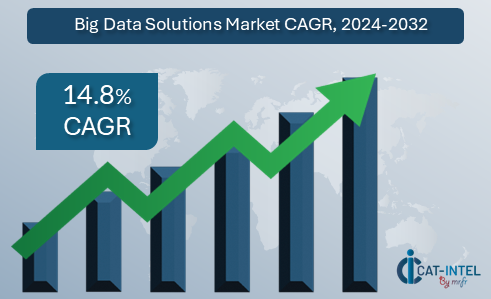
- Sector Contributions:
- BFSI and Retail: Lead adoption due to a focus on customer insights and operational efficiencies.
- Healthcare: Rising usage for predictive analytics in patient care and resource management.
- Manufacturing: Enhancing production and supply chain visibility with real-time analytics.
- Technological Innovations:
AI-driven analytics, hybrid cloud solutions, and advancements in data visualization are driving operational efficiencies and fostering new business opportunities. - Regional Insights:
- North America dominates the market due to its mature technology infrastructure and widespread cloud adoption.
- The Asia-Pacific region is expected to witness the fastest growth due to investments in smart city initiatives and an expanding e-commerce ecosystem.
- Europe shows strong growth, especially in retail and telecom, leveraging big data to enhance customer experiences.
Key Trends and Sustainability Outlook
- Sustainability Initiatives: Optimized energy consumption for data centers and eco-friendly data processing methods.
- Data Security and Governance: Increased emphasis on compliance with regulations like GDPR and CCPA.
- Growth Drivers:
- Increasing enterprise data volumes.
- Growing reliance on customer insights for competitive differentiation.
- Expanding applications in predictive maintenance, fraud detection, and personalized marketing.
Overview of Market Intelligence Services for Big data solutions
Big data procurement strategies increasingly involve partnerships with vendors offering integrated analytics solutions, ensuring cost-effective implementations and long-term operational benefits. Insights on pricing, vendor performance assessments, and strategic sourcing are crucial to maintaining competitiveness in this dynamic market
Procurement Intelligence for Big Data Solutions Market: Category Management and Strategic Sourcing
In the evolving Big Data Solutions market, organizations are refining procurement strategies to leverage the vast potential of data-driven decision-making. Companies are employing advanced analytics for spend analysis, enhancing vendor performance tracking, and optimizing procurement workflows through AI-powered tools. Strategic sourcing and category management have become pivotal in ensuring cost-efficiency and supplier alignment.

Pricing Outlook for Big Data Solutions Market: Spend Analysis
The Big Data solutions market is experiencing a dynamic pricing landscape influenced by advancements in technology, increasing demand for data analytics, and cloud-based solutions. This environment is further shaped by factors like evolving enterprise needs and regulatory compliance.
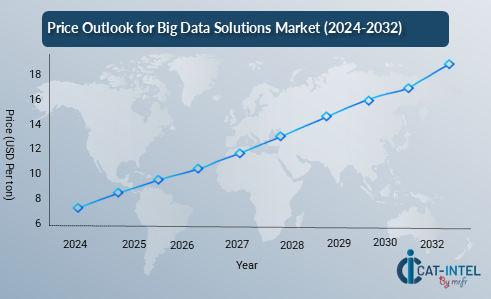
line chart illustrating the pricing outlook for the Big data solutions from 2024 to 2032. The chart shows the projected price trends, with prices gradually increasing over the years.
Comprehensive Price Forecast:
- Rising Infrastructure Costs: The adoption of cloud-based platforms and AI-driven analytics has elevated infrastructure investments, contributing to overall pricing growth.
- Growing Demand for Analytics: The increasing need for real-time insights across industries such as BFSI, healthcare, and retail drives the demand for scalable Big Data solutions, intensifying market competition.
- Global Expansion: Emerging markets, particularly in Asia-Pacific, are experiencing rapid adoption, creating opportunities but also price volatility due to varying regional cost structures.
- Regulatory Impact: Compliance requirements like GDPR and other data privacy laws compel enterprises to invest in secure and compliant Big Data solutions, influencing price models.
- Technological Integration: Advances in AI, machine learning, and IoT integration are transforming pricing frameworks, with premium solutions commanding higher costs due to their capabilities.
Cost Breakdown for the Big Data Solutions : Cost saving opportunities
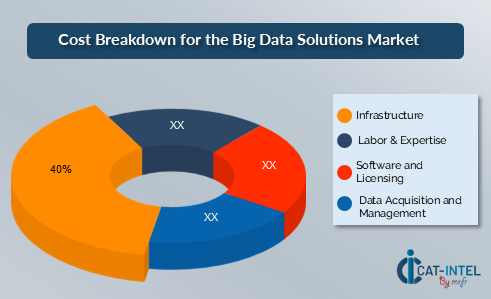
- Infrastructure (40%)
- Description: Includes costs associated with cloud platforms, on-premises servers, and hybrid infrastructures required for big data storage and processing. This is influenced by scalability, storage needs, and integration requirements.
- Trends: Growing reliance on scalable cloud solutions and hybrid models due to increased data volumes and the need for real-time analytics. Cloud adoption is anticipated to rise steadily, reducing dependency on traditional on-premises setups.
- Software and Licensing (XX%)
- Labor and Expertise (XX%)
- Data Acquisition and Management (XX%)
Cost saving opportunity: Negotiation Lever and Purchasing Negotiation Strategies
In the Big Data Solutions market, cost-saving opportunities revolve around vendor consolidation, optimizing cloud and on-premises infrastructure, and leveraging advanced analytics tools to identify inefficiencies. Negotiation levers include volume-based pricing agreements, flexible licensing terms, and bundling services to achieve discounts. Efficient use of predictive analytics and real-time monitoring can further reduce operational costs by minimizing redundancies and improving resource allocation.
Supply and Demand Overview of the Big Data Solutions Market: Demand-Supply Dynamics and Buyer Intelligence for Effective Supplier Relationship Management (SRM)
Demand Factors:
- Data-Driven Decision-Making: Organizations increasingly leverage big data to enhance business strategies, optimize operations, and improve customer experiences.
- Digital Transformation: The global shift towards digital processes accelerates the demand for advanced big data analytics tools.
- AI and Machine Learning Integration: The adoption of AI and machine learning technologies relies heavily on robust data analytics capabilities, driving demand for big data solutions.
- Industry-Specific Applications: Sectors such as healthcare, finance, and retail continue to expand big data use for predictive analytics, fraud detection, and customer behavior analysis.
Supply Factors:
- Expanding Vendor Ecosystem: Growth in the number of specialized big data solution providers ensures a competitive and diverse supply.
- Cloud Adoption: Increased cloud integration facilitates scalability, offering solutions to meet various business needs cost-effectively.
- Technology Advancements: Progress in processing speed, storage capacity, and analytics frameworks enhances the availability of cutting-edge solutions.
- Global Accessibility: Enhanced infrastructure and partnerships in emerging markets improve accessibility to big data services globally.
Regional Demand-Supply Outlook: Big Data Solutions Market
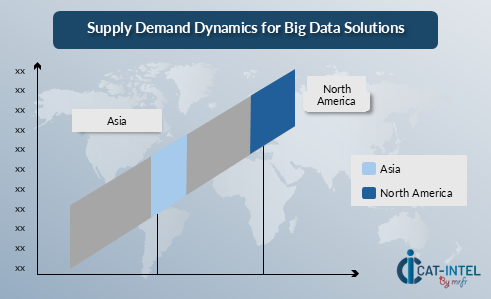
The image shows growing demand for big data solutions in both North America and Asia, with potential price increases and increased competition
North America: A Leading Region in Big Data Solutions
North America is a prominent player in the Big Data Solutions market, driven by:
- Leading Technological Infrastructure: The U.S. and Canada are at the forefront of technological advancements, making them major hubs for big data adoption and innovation.
- High Adoption of AI and ML: Businesses in the region are integrating Artificial Intelligence (AI) and Machine Learning (ML) into analytics solutions for real-time data insights and predictive modelling.
- Robust Cloud Adoption: Cloud-based analytics solutions are widely deployed due to their scalability and cost-efficiency, which allow businesses to manage vast datasets seamlessly.
- Focus on Data Security and Compliance: With stringent regulations like GDPR and CCPA, organizations emphasize secure and compliant data practices to maintain trust and meet legal requirements.
- Booming Healthcare Analytics: During the pandemic, healthcare emerged as a significant user of big data analytics for monitoring trends, resource allocation, and decision-making.
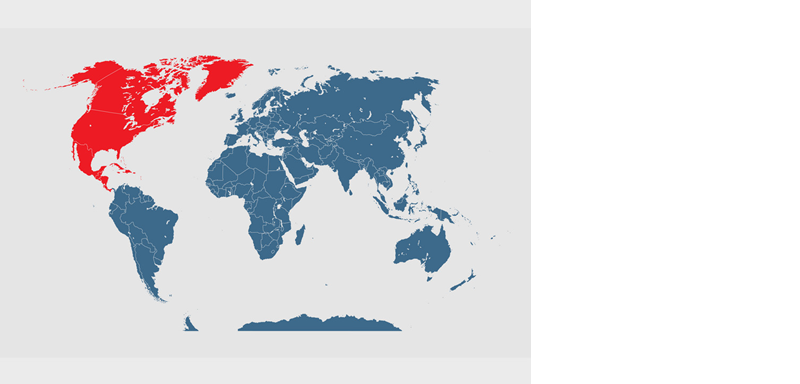
North America remains a key hub Big Data solution and its growth
Supplier Landscape: Supplier Negotiations and Strategies
The Big Data Solutions market is currently experiencing significant growth, driven by an increasing reliance on data analytics to enhance decision-making across various industries. As organizations collect more data than ever before, they are turning to big data solutions to manage, analyse, and derive actionable insights from vast amounts of information. These solutions are central to sectors like healthcare, finance, e-commerce, and manufacturing, where real-time analytics and predictive insights are becoming more critical.
Key suppliers in the Big Data Solutions market
- Amazon Web Services (AWS)
- Microsoft Azure
- Google Cloud
- IBM
- Oracle
- Cloudera
- Snowflake
- SAP
- Palantir Technologies.
- Hadoop (Apache)
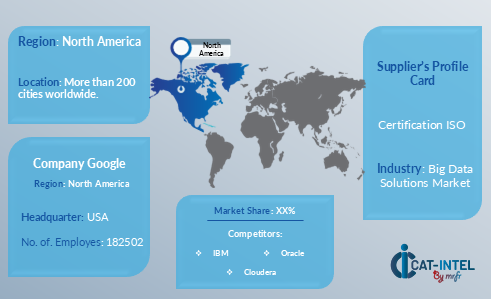
Key Development: Procurement Category significant development
|
Key Development |
Description |
|
Digitalization and Automation |
Integration of AI, machine learning, and analytics to streamline procurement processes, improving efficiency and decision-making. |
|
Sustainability and Green Procurement |
Focus on purchasing environmentally friendly materials and promoting sustainable practices in procurement, driven by regulatory and consumer pressures. |
|
Supplier Collaboration |
Building long-term partnerships with suppliers, engaging them in early stages of product development to drive innovation and enhance supply chain resilience. |
|
Global Sourcing and Risk Management |
Diversification of supplier base to mitigate geopolitical, environmental, and supply chain risks, with an emphasis on risk management and contingency planning. |
|
Procurement Attribute/Metric |
Details |
|
Market Sizing |
The Big Data market is projected to grow from USD 229.4 billion in 2024 to USD 650 billion by 2032, with a CAGR of 14.8%. |
|
Adoption of Big Data Solutions |
Increasing adoption across industries like healthcare, retail, BFSI, and manufacturing, driven by the need for real-time analytics and data-driven decision-making. |
|
Top Strategies for 2024 |
Focus on AI and machine learning integration, data security enhancements, cloud-based big data solutions, and data democratization within organizations. |
|
Automation in Big Data Processing |
Over 50% of organizations are adopting AI and automation tools to streamline data collection, processing, and analysis, enhancing operational efficiency. |
|
Procurement Challenges |
Key challenges include data privacy and security concerns, high implementation costs, and the complexity of integrating big data solutions with existing systems. |
|
Key Suppliers |
Major players include IBM, Microsoft, Oracle, SAP, and SAS, offering big data platforms, cloud solutions, and data analytics tools. |
|
Key Regions Covered |
Major markets include North America, Europe, and Asia-Pacific, with significant demand from the U.S., China, and India. |
|
Market Drivers and Trends |
Growth is driven by increasing volumes of data, advancements in AI and machine learning, demand for real-time analytics, and digital transformation initiatives across industries. |
Frequently Asked Questions (FAQ):
Procurement intelligence services provide insights into the global big data solutions market. Services such as spend analysis, supplier evaluations, and market intelligence help businesses source solutions efficiently, ensuring cost-effectiveness and access to top suppliers.
To evaluate TCO for big data solutions, costs for procurement, implementation, integration, maintenance, and operational expenses are considered. This analysis helps businesses understand the long-term impact of adopting big data technologies.
Risk management strategies include addressing data security concerns, ensuring vendor reliability, and handling technology integration challenges. Solutions also focus on mitigating risks like data breaches and system incompatibilities.
Supplier relationship management (SRM) helps optimize supplier partnerships, ensuring better collaboration, favourable terms, and service reliability. This enhances the value derived from sourcing big data solutions.
Best practices include efficient vendor selection, pricing strategy development, and managing contracts. These practices ensure that businesses make informed and strategic procurement decisions.
Digital transformation streamlines procurement by automating processes and leveraging real-time data analytics for smarter decisions. It helps track vendor performance and market trends, improving procurement strategies.
Supplier performance management ensures that vendors meet required standards in quality, delivery, and compliance. It provides ongoing evaluation, which helps optimize future procurement decisions.
Data-driven negotiation strategies help secure competitive pricing, discounts, and favorable terms with suppliers. Market intelligence aids in these negotiations, ensuring favorable outcomes for procurement.
Tools that offer insights into market trends, supplier market share, and price forecasts help businesses stay informed and make strategic purchasing decisions based on real-time data.
Compliance with data protection regulations (e.g., GDPR) is ensured by selecting vendors who adhere to industry standards for data security and privacy. Procurement solutions help navigate these complex requirements.
Strategies for managing disruptions include identifying alternative suppliers and creating contingency plans. Monitoring market trends helps anticipate and address potential supply issues.
Regular monitoring through supplier performance tracking tools helps assess quality, service, and compliance, ensuring that suppliers continue to meet the organization's standards.
Sustainability practices include choosing vendors who focus on energy-efficient data centers and reducing their environmental impact. These considerations align with corporate social responsibility goals.
Competitive pricing is achieved by comparing costs across different vendors and understanding market dynamics. Pricing analysis tools help ensure that businesses get the best value from their suppliers.
Market opportunities include the growing demand for data analytics, cloud computing, and AI-powered solutions. However, risks include vendor lock-in, high implementation costs, and data security concerns.








